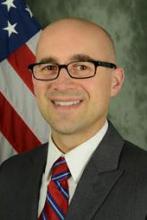Monte Carlo simulations for texture-controlled grain growth during beta-annealing of Ti-6Al-4V
Date & Time:
Fri, 04/15/2022 - 2:00pmSpeaker:
Eric J. PaytonJob title:
Research LeaderAffiliation:
Materials and Manufacturing Directorate, Air Force Research LaboratoryLocation:
Discover Park D201Abstract:
Alpha/beta titanium alloys such as Ti-6Al-4V often undergo beta annealing to improve fatigue crack growth resistance. Under certain processing paths, the microstructure may exhibit abnormal growth kinetics, leading to coarse grains that may be detrimental to component durability. Previous studies have suggested this is a texture-controlled process which relies on spatial non-uniformities in grain boundary mobility and energy, giving a select few grains an advantage for growth. The present work uses Monte Carlo simulations of grain growth to systematically study the most important factors leading to coarse grain development. The texture-controlled nature of coarse grain growth is explored by considering the influence of grain boundary mobility and energy as a function of misorientation, as well as the stored energy of the grains.

Biography:
Dr. Eric Payton serves as the Research Leader for the Metallic Materials and Processing Team at the Air Force Research Laboratory Materials and Manufacturing Directorate. His research focuses on the development of novel techniques for characterization and modeling of materials microstructure evolution during thermomechanical processing of metallic materials. Prior to transitioning to government service in 2015, he was an Assistant Professor of Materials Science and Engineering at the New York State College of Ceramics at Alfred University, held post-doctoral positions at Ruhr University in Bochum, Germany, and the Federal Institute for Materials Research and Testing in Berlin, Germany, and obtained a PhD in Materials Science and Engineering from The Ohio State University.
Seminar ID:
202204151400Department:
Materials Science and Engineering